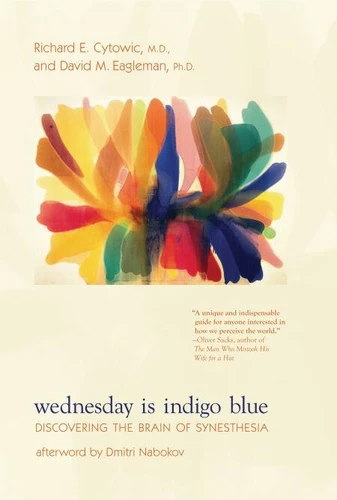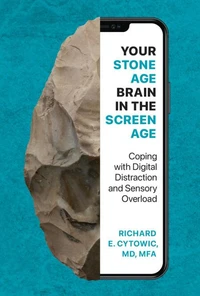Wednesday Is Indigo Blue. Discovering the Brain of Synesthesia
Par : , ,Formats :
Disponible dans votre compte client Decitre ou Furet du Nord dès validation de votre commande. Le format ePub protégé est :
- Compatible avec une lecture sur My Vivlio (smartphone, tablette, ordinateur)
- Compatible avec une lecture sur liseuses Vivlio
- Pour les liseuses autres que Vivlio, vous devez utiliser le logiciel Adobe Digital Edition. Non compatible avec la lecture sur les liseuses Kindle, Remarkable et Sony
- Non compatible avec un achat hors France métropolitaine
 , qui est-ce ?
, qui est-ce ?Notre partenaire de plateforme de lecture numérique où vous retrouverez l'ensemble de vos ebooks gratuitement
Pour en savoir plus sur nos ebooks, consultez notre aide en ligne ici
- Nombre de pages320
- FormatePub
- ISBN978-0-262-26055-8
- EAN9780262260558
- Date de parution30/09/2011
- Protection num.Adobe DRM
- Taille12 Mo
- Infos supplémentairesepub
- ÉditeurThe MIT Press
Résumé
Revealing the neuroscience and genetics behind synesthesia-and how this multi-sensory phenomenon changed our view of the brain. A person with synesthesia might feel the flavor of food on her fingertips, sense the letter "J" as shimmering magenta or the number "5" as emerald green, hear and taste her husband's voice as buttery golden brown. Synesthetes rarely talk about their peculiar sensory gift-believing either that everyone else senses the world exactly as they do, or that no one else does.
Yet synesthesia occurs in 1 in 20 people, and is even more common among artists. One famous synesthete was novelist Vladimir Nabokov, who insisted as a toddler that the colors on his wooden alphabet blocks were "all wrong." His mother understood exactly what he meant because she, too, had synesthesia. Nabokov's son Dmitri, who recounts this tale in the afterword to this book, is also a synesthete-further illustrating how synesthesia runs in families.
Wednesday Is Indigo Blue reveals how the extraordinary multisensory phenomenon of synesthesia has changed our traditional view of the brain. Because synesthesia contradicted existing theory, researcher Richard Cytowic spent 20 years persuading colleagues that it was a real-and important-brain phenomenon rather than a mere curiosity. Today, scientists in 15 countries are exploring synesthesia and how it is changing the traditional view of how the brain works.
Cytowic and neuroscientist David Eagleman argue that perception is already multisensory, though for most of us its multiple dimensions exist beyond the reach of consciousness. Reality, they point out, is more subjective than most people realize. No mere curiosity, synesthesia is a window on the mind and brain, highlighting the amazing differences in the way people see the world.
Yet synesthesia occurs in 1 in 20 people, and is even more common among artists. One famous synesthete was novelist Vladimir Nabokov, who insisted as a toddler that the colors on his wooden alphabet blocks were "all wrong." His mother understood exactly what he meant because she, too, had synesthesia. Nabokov's son Dmitri, who recounts this tale in the afterword to this book, is also a synesthete-further illustrating how synesthesia runs in families.
Wednesday Is Indigo Blue reveals how the extraordinary multisensory phenomenon of synesthesia has changed our traditional view of the brain. Because synesthesia contradicted existing theory, researcher Richard Cytowic spent 20 years persuading colleagues that it was a real-and important-brain phenomenon rather than a mere curiosity. Today, scientists in 15 countries are exploring synesthesia and how it is changing the traditional view of how the brain works.
Cytowic and neuroscientist David Eagleman argue that perception is already multisensory, though for most of us its multiple dimensions exist beyond the reach of consciousness. Reality, they point out, is more subjective than most people realize. No mere curiosity, synesthesia is a window on the mind and brain, highlighting the amazing differences in the way people see the world.
Revealing the neuroscience and genetics behind synesthesia-and how this multi-sensory phenomenon changed our view of the brain. A person with synesthesia might feel the flavor of food on her fingertips, sense the letter "J" as shimmering magenta or the number "5" as emerald green, hear and taste her husband's voice as buttery golden brown. Synesthetes rarely talk about their peculiar sensory gift-believing either that everyone else senses the world exactly as they do, or that no one else does.
Yet synesthesia occurs in 1 in 20 people, and is even more common among artists. One famous synesthete was novelist Vladimir Nabokov, who insisted as a toddler that the colors on his wooden alphabet blocks were "all wrong." His mother understood exactly what he meant because she, too, had synesthesia. Nabokov's son Dmitri, who recounts this tale in the afterword to this book, is also a synesthete-further illustrating how synesthesia runs in families.
Wednesday Is Indigo Blue reveals how the extraordinary multisensory phenomenon of synesthesia has changed our traditional view of the brain. Because synesthesia contradicted existing theory, researcher Richard Cytowic spent 20 years persuading colleagues that it was a real-and important-brain phenomenon rather than a mere curiosity. Today, scientists in 15 countries are exploring synesthesia and how it is changing the traditional view of how the brain works.
Cytowic and neuroscientist David Eagleman argue that perception is already multisensory, though for most of us its multiple dimensions exist beyond the reach of consciousness. Reality, they point out, is more subjective than most people realize. No mere curiosity, synesthesia is a window on the mind and brain, highlighting the amazing differences in the way people see the world.
Yet synesthesia occurs in 1 in 20 people, and is even more common among artists. One famous synesthete was novelist Vladimir Nabokov, who insisted as a toddler that the colors on his wooden alphabet blocks were "all wrong." His mother understood exactly what he meant because she, too, had synesthesia. Nabokov's son Dmitri, who recounts this tale in the afterword to this book, is also a synesthete-further illustrating how synesthesia runs in families.
Wednesday Is Indigo Blue reveals how the extraordinary multisensory phenomenon of synesthesia has changed our traditional view of the brain. Because synesthesia contradicted existing theory, researcher Richard Cytowic spent 20 years persuading colleagues that it was a real-and important-brain phenomenon rather than a mere curiosity. Today, scientists in 15 countries are exploring synesthesia and how it is changing the traditional view of how the brain works.
Cytowic and neuroscientist David Eagleman argue that perception is already multisensory, though for most of us its multiple dimensions exist beyond the reach of consciousness. Reality, they point out, is more subjective than most people realize. No mere curiosity, synesthesia is a window on the mind and brain, highlighting the amazing differences in the way people see the world.




